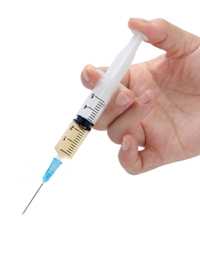4.3 Prolonged-release antipsychotic injections
 Prolonged-release (‘depot’) formulations of antipsychotics are administered by deep intramuscular injection and form a depot at the injection site from which the antipsychotic is released at a fairly steady rate into the blood, typically over several weeks. In the UK, an estimated 30% of patients with schizophrenia1 are treated with a prolonged-release injectable antipsychotic.
Prolonged-release (‘depot’) formulations of antipsychotics are administered by deep intramuscular injection and form a depot at the injection site from which the antipsychotic is released at a fairly steady rate into the blood, typically over several weeks. In the UK, an estimated 30% of patients with schizophrenia1 are treated with a prolonged-release injectable antipsychotic.
Prolonged-release injections of antipsychotics may overcome poor adherence to oral antipsychotic regimens and help to improve relapse rate.
However, use of long-acting antipsychotic injection is associated with the following disadvantages:
- Intramuscular injection is uncomfortable and may produce injection-site reactions
- Dose titration may be more difficult than with immediate-acting oral formulations
- Adverse effects may persist until the drug has been cleared from its depot site
Antipsychotic | Proprietary names | Usual dose frequency |
|---|---|---|
Flupentixol decanoate | Depixol, Depixol Conc., Depixol Low Volume | Every 2–4 weeks |
Fluphenazine decanoate | Modecate, Modecate Concentrate | Every 2–5 weeks |
Haloperidol decanoate | Haldol Decanoate | Every 2–4 weeks |
Olanzapine embonate | ZypAdhera | Every 2–4 weeks |
Palipideridone palmitate | Xeplion | Every month |
Pipotiazine palmitate | Piportil Depot | Every 4 weeks |
Risperidone | Risperdal Consta | Every 2 weeks |
Zuclopenthixol decanoate | Clopixol, Clopixol Conc. | Every 1–4 weeks |
Risk-reduction measures
Patients should ideally be stabilised on the oral version of the intended prolonged-release antipsychotic. On starting the prolonged-release regimen, the dose of the oral antipsychotic is reduced gradually and then stopped; however, a prolonged-release antipsychotic injection should not be given with clozapine (see Clozapine). For maintenance treatment, only one antipsychotic should be used.
Prolonged-release antipsychotic should generally be initiated in a specialist mental health setting; for certain antipsychotics, treatment should be stated with a small test dose. The patient should be carefully monitored for the first 1–2 months and sufficient time allowed for stabilisation before adjusting the dose. The dose should be adjusted to the lowest possible that controls the symptoms.
Injection instructions should be carefully followed and the strength of the injection should be selected to avoid injecting unduly large volume. Injection into a blood vessel must be avoided; correct choice of injection site and, if appropriate, aspiration before injection can prevent inadvertent intravascular injection. The patient should avoid strenuous exercise immediately after injection—increased muscle blood flow can hasten absorption of the antipsychotic and cause unexpectedly severe side effects.
- A mental disorder which affects how the individual feels, behaves and thinks↩